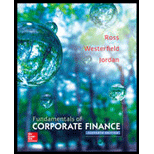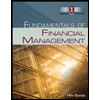
a)
To calculate: The EPS (Earnings per share) under three scenarios before the debt issue and the changes in EPS while the economy expands a recession.
Introduction:
The EPS is the part of the profit of a firm that is allocated to every outstanding share of the common stock. It indicates the profitability of the company.
Answer:
The EPS under the recession, normal, and expansion periods are $1.61, $2.48, and $3.10 respectively and the percentage of change in EPS is -35% and +25 for the recession and expansion periods respectively.
a)
Answer to Problem 2QP
The EPS under the recession, normal, and expansion periods are $1.61, $2.48, and $3.10 respectively and the percentage of change in EPS is -35% and +25 for the recession and expansion periods respectively.
Explanation of Solution
Given information:
Company R has no debt outstanding and its market value is $165,000. The EBIT (Earnings before interest and taxes) are expected to be $21,000 at normal economic conditions. If the economy condition is strong, then EBIT will increase to 25% and if the economy enters into recession, then it will decrease to 35%. The tax rate of the company is 35%.
Formula to calculate taxes:
Compute taxes for three periods:
Hence, the tax during recession is $4,778.
Hence, the tax during normal period is $7,350.
Hence, the tax during expansion is $9,188.
Formula to calculate the NI (Net Income):
Compute NI for three periods:
Hence, the net income during recession is $8,872.
Hence, the net income during normal period is $13,650.
Hence, the net income during expansion period is $17,063.
Formula to calculate EPS:
Compute EPS:
Hence, the EPS during recession period is $1.61.
Hence, the EPS during normal period is $2.48.
Hence, the EPS during expansion period is $3.10.
Table showing the income statement for three possible periods of economy with the EPS and percentage change in EPS:
| Recession | Normal | Expansion | |
| EBIT | $13,650 | $21,000 | $26,250 |
| Interest | 0 | 0 | 0 |
| Taxes | 4,778 | 7,350 | 9,188 |
| NI | $ 8,873 | $13,650 | $17,063 |
| EPS | $1.61 | $2.48 | $3.10 |
| %ΔEPS | –35 | NIL | 25 |
Note:
It is given that during the recession period, the EBIT will decrease to 35% and during the expansion period, EBIT will increase to 25%.
b)
To calculate: The EPS (Earnings per share) under three scenarios before the debt issue and the changes in EPS while the economy expands a recession by assuming that the firm undergoes the planned recapitalization.
Introduction:
The EPS is the part of the profit of a firm that is allocated to every outstanding share of the common stock. It indicates the profitability of the company.
Answer:
After recapitalization, the EPS under the recession, normal, and expansion periods are $1.76, $3.12, and $4.10 respectively and the percentage of change in EPS is -43.75% and +31.25 for the recession and expansion periods respectively.
b)
Answer to Problem 2QP
After recapitalization, the EPS under the recession, normal, and expansion periods are $1.76, $3.12, and $4.10 respectively and the percentage of change in EPS is -43.75% and +31.25 for the recession and expansion periods respectively.
Explanation of Solution
Given information:
The company is considering the debt issue of $60,000 with the rate of interest @7%. At present, the outstanding shares of $5,500 exist.
Formula to calculate the share price:
Compute the share price:
Hence, the price of the share is $30.
Formula to calculate the repurchased shares:
Compute the repurchased shares:
Hence, the repurchased shares are $2,000.
Formula to calculate the payment of interest:
Compute the payment of interest:
Hence, the payment of interest is $4,200.
Formula to calculate taxes:
Compute taxes for three periods:
Hence, the tax during recession is $3,307.5.
Hence, the tax during normal period is $5,880.
Hence, the tax during expansion period is $7,718.
Formula to calculate the NI (Net Income):
Compute NI for three periods:
Hence, the net income during recession is $6,143.
Hence, the net income during normal period is $10,920.
Hence, the net income during expansion period is $14,333.
Formula to calculate EPS:
Compute EPS:
Hence, the EPS @ recession period is $1.76.
Hence, the EPS @ normal period is $3.12.
Hence, the EPS @ expansion period is $4.10.
Note: After recapitalization, $2,000 was recovered from the total outstanding shares of $5,500. Now, the shares outstanding is $5,500-$2,000=$3,500.
Formula to calculate the percentage change in EPS:
Compute the percentage change in EPS for recession period:
Hence, the percentage change in EPS for recession period is -$43.75.
Compute the percentage change in EPS for expansion period:
Hence, the percentage change is EPS for expansion period is 31.25.
Table showing the income statement for three possible periods of economy under the planned recapitalization with the EPS and percentage change in EPS:
| Recession | Normal | Expansion | |
| EBIT | $13,650 | $21,000 | $26,250 |
| Interest | 4,200 | 4,200 | 4,200 |
| Taxes | 3,308 | 5,880 | 7,718 |
| NI | $6,143 | $10,920 | $14,333 |
| EPS | $1.76 | $3.12 | $4.10 |
| %ΔEPS | –43.75 | NIL | 31.25 |
Want to see more full solutions like this?
Chapter 16 Solutions
Fundamentals of Corporate Finance
- No ai The time value of money concept suggests:A. Money loses value over timeB. Inflation doesn’t matterC. Future money is more valuableD. Money today is worth more than tomorrowarrow_forwardA food processing company is considering replacing essential machinery. Cost and relevant cash flow details are provided in the table at the right. The company requires an 11% return on its capital. a) What is the present value of the yearly cash flows? Use a Time Value of Money function for full credit. (round to nearest dollar) b) What is the net present value of the project? (round to nearest dollar) c) What is the internal rate of return of the project? Use a Time Value of Money function for full credit. (round to two decimal places)arrow_forwardwhat is the firms' weighted average cost of capital? please show me weight calculation for each capital source.arrow_forward
- A small manufacturer is considering an equipment replacement project. The new equipment would have an installed cost of $125,000 and would replace existing equipment that was purchased 3 years ago at an installed cost of $80,000. If the company moves forward with the replacement, it could sell the old equipment for $25,000. Purchasing the new equipment would result in the company's current assets increasing by $12,000 and current liabilities increasing by $9,000. The company uses the 5-year MACRS table for depreciation, and is taxed at 21%. a) What is the accumulated depreciation of the old equipment? b) What is the current book value of the old equipment? c) What is the amount of depreciation recapture/recovery? d) What is the tax on the sale of the old equipment? e) What are the after-tax proceeds from the sale of the old equipment? f) What is the change in Net Working Capital? g) What is the initial investment for the project?arrow_forwardLast year Lewis Bank paid an annual dividend of $7 per share. The bank expects the growth of its dividends to be stable at 2% per year going forward. a) If investors require an 8% return, what is the current value of Lewis Bank's stock? (round to nearest cent) b) If the stock currently trades at $124.55 per share, what is the dividend growth rate investors expect? (round to nearest percent)arrow_forwardA food processing company is considering replacing essential machinery. Cost and relevant cash flow details are provided in the table at the right. The company requires an 11% return on its capital. a) What is the present value of the yearly cash flows? Use a Time Value of Money function for full credit. (round to nearest dollar) b) What is the net present value of the project? (round to nearest dollar) c) What is the internal rate of return of the project? Use a Time Value of Money function for full credit. (round to two decimal places)arrow_forward
- Barnsa is planning to raise a total of $5,000,000 with a bond issue. Each of the bonds has a face (par) value of $1,000 and coupon rate of 4%. The company's applicable tax rate is 21%. a) What is the annual coupon payment, per bond, that investors expect to receive? b) What is the total after-tax annual interest expense to Barnsa?arrow_forwardA team of analysts is using a two-stage variable growth model to estimate the value of GNC's common stock. The most recent annual dividend paid by GNC was $4 per share. The analysts expect dividends to increase 7% per year for the next 3 years and then drop to 3% starting in year 4 and remain at that rate for the foreseable future. The required rate of return used for the analysis is 8%. a) What are the expected dividends for the next 4 years? b) What is the value of the stock attributable to the first 3 years of dividends? (use NPV function) c) What is the value of the stock at the end of year 3? (use constant-growth model) Use a cell reference in the numerator to get an unrounded, more precise, answer figure. d) What is the value of the stock attributable to years 4 and beyond? (use pv function, where answer to part C is the fv) e) What is the total value of GNC stock?arrow_forwardAn investor is buying a bond that pays semi-annual interest. The par value is $900 and the coupon rate is 6%. The investor plans to hold the bond to its maturity, which is 5 years from now. If her typical required rate of return is 7%, what is the most the investor should pay for the bond? Use a Time Value of Money function for full credit. (round to nearest cent)arrow_forward
- IRR: Mutually exclusive projects Nile Inc. wants to choose the better of two mutually exclusive projects that expand warehouse capacity. The projects' cash flows are shown in the following table: The cost of capital is 18%. a. Calculate the IRR for each of the projects. Assess the acceptability of each project on the basis of the IRRs. b. Which project is preferred? a. The internal rate of return (IRR) of project X is %. (Round to two decimal places.) Is project X acceptable on the basis of IRR? (Select the best answer below.) Yes No The internal rate of return (IRR) of project Y is %. (Round to two decimal places.) Is project Y acceptable on the basis of IRR? (Select the best answer below.) ○ Yes Ο No b. Which project is preferred? (Select the best answer below.) A. Project X B. Project Y C. Neitherarrow_forwardA preferred stock has a par value of $105 and pays an annual dividend of 3% of par. If similar investments have an annual rate of return of 5%, what is the current value of this preferred stock. (round to nearest cent)arrow_forwardCommon stock value-Variable growth Lawrence Industries' most recent annual dividend was $1.82 per share (Do = $1.82), and the firm's required return is 15%. Find the market value of Lawrence's shares when dividends are expected to grow at 30% annually for 3 years, followed by a 6% constant annual growth rate in years 4 to infinity. The market value of Lawrence's shares is $ (Round to the nearest cent.)arrow_forward
 Fundamentals of Financial Management (MindTap Cou...FinanceISBN:9781285867977Author:Eugene F. Brigham, Joel F. HoustonPublisher:Cengage Learning
Fundamentals of Financial Management (MindTap Cou...FinanceISBN:9781285867977Author:Eugene F. Brigham, Joel F. HoustonPublisher:Cengage Learning Intermediate Financial Management (MindTap Course...FinanceISBN:9781337395083Author:Eugene F. Brigham, Phillip R. DavesPublisher:Cengage Learning
Intermediate Financial Management (MindTap Course...FinanceISBN:9781337395083Author:Eugene F. Brigham, Phillip R. DavesPublisher:Cengage Learning




